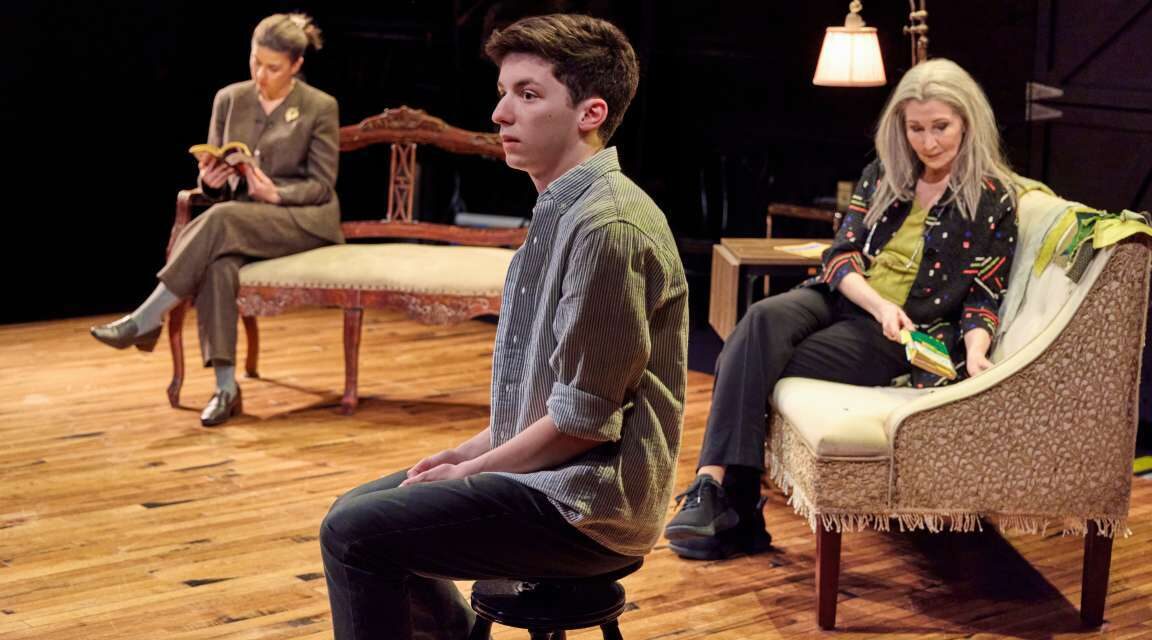By Barbara & Scott Siegel…
Let’s start at the top and work our way down…
Excellent:
As any serious theatergoer will tell you, the best shows can usually be found Off-Broadway. That’s why so many of the best Broadway shows are transfers from Off-Broadway. But right now, let’s just look at one truly wonderful Off-Broadway show at Manhattan Theatre Club’s Stage II titled We Had a World by Joshua Harmon.
Clearly autobiographical, Harmon’s new family drama is his version of “Portrait of the Artist as a Young Man.” Joshua Harman makes no pretense that Andrew Barth Feldman is playing anyone but him: the character’s name is Joshua. Jeanine Serralles plays Ellen, his mother, and Joanna Gleason plays his grandmother, Renee. And that’s the whole cast, and we don’t need anyone else to help tell this story because it’s all about the gravitational pull each of these powerful, flawed, all-important women have on him throughout his early life, from childhood to early adulthood. Throughout, Harmon manages to connect small moments in time that might seem random into a tightly woven narrative of complex emotions.
Very much a New York story, we suspect this play will not get as many laughs out of town; the references to specific places like Serendipity, or a glove store on Madison Avenue get knowing reactions from the local audience. Even so, the push/pull between these two commanding people is palpable with both Gleason and Serralles giving richly detailed, humanly authentic performances. For Gleason, it could be the capstone to a brilliant career.
Young Mr. Feldman keeps the play grounded with the help of Harmon’s willingness to admit to his own self-centeredness. There is one scene in which a teenage Joshua, having just performed in a play, is so self-involved that he is unaware of his mother’s grief and his grandmother’s betrayal on the ride home. So human, so real, so honest.
Like any true family drama, there is pain, there is laughter, there is love, there is hurt. And it’s all on display in this deeply affecting work, so tenderly directed by Tripp Cullman, with exquisitely perfect costume design by Kaye Voyce that tells you everything about these characters in a single glance.
By the end of the play, you can’t help but understand the forces that shaped this bright young playwright who has already given us such significant plays as Prayer for the French Republic, Skintight, Admissions, Significant Other, and Bad Jews. And now we know why.
Okay:
There is a reason that David Mamet’s Glengarry Glen Ross gets revived so often: it has great parts for almost every actor in the play. The current Broadway revival at The Palace Theatre, that ostensibly stars Kieran Culkin as Richard Roma, but also features Bob Odenkirk as Shelley “the Machine” Levene, and comedian Bill Burr as Dave Moss, proves one undeniable fact: Mamet’s writing is the real star of the show.
Everyone is solid, giving totally credible performances. The one problem with a play that gets revived so often, and that has been turned into a star-driven movie, is that it’s pretty hard to top what has come before. Comparisons are inevitable. Culkin is no Pacino. Odenkirk is no Jack Lemmon, and so it goes. So, one doesn’t get too excited about the performances. But one does get excited to once again feel the force of Mamet’s virile examination of capitalism at this brutish level, leavened only by the respect and admiration that Roma has for his one-time mentor, Levene. That relationship is touching in the face of so much “me, me, me.” And to give him his due, Culkin is less hard edged versus others who have played this role, and that gives his kindness more impact.
Director Patrick Marber wisely lets the text lead the way in this respectful staging; he isn’t trying to re-invent the play — THANK YOU FOR THAT! — he is giving another generation a chance to witness great playwriting. And David Mamet — THANK YOU FOR THAT!
UH-OH:
There are two great things to say about Redwood, the new musical at The Nederlander Theatre starring Idina Menzel. The first is that Menzel and the entire cast sing their faces off throughout the entire show; if you like big, Broadway belting, there is at least this one element to admire. The second is the projections/Video Design by Hana S. Kim: it makes this show visually stunning in ways that neither the book nor the score come close to — which is a shame, because you are not going to leave the theater singing the video design.
Let’s start with the book by Tina Landau, based on a concept by Landau and Menzel. The story upon which this musical is built is, in a word, pretentious. A mother loses her son and she falls apart. After a year of spiraling downward, she finally runs away from her New York City home and business to the Redwood forest in Northern California where she confronts her demons.


